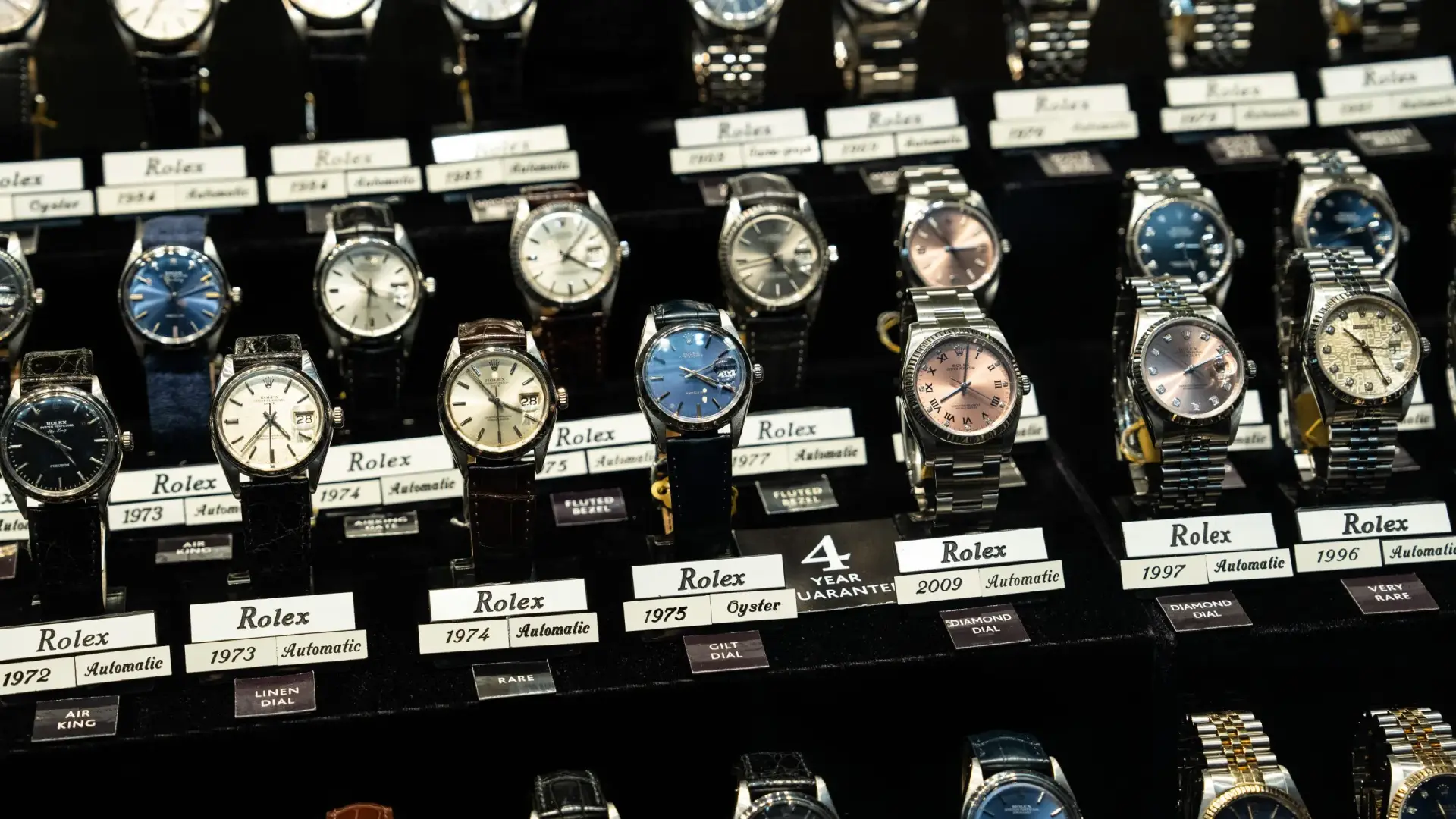What Is a GMT Watch? The Traveler’s Guide to Dual Timepieces
Watch Guides
2025-09-12Introduction
Maybe you first heard the term GMT in school, noticed it on a traveler’s wrist at the airport, or discovered it while looking for a watch to accompany your adventures—whatever the case, GMT has a lot of significance in the watchmaking industry.
In this guide, we’ll explain what a GMT watch is, how it works, and how to choose the right GMT watch one for your lifestyle.
What is GMT?
GMT stands for Greenwich Mean Time, the global time standard established in the 19th century. It serves as the reference point for all other time zones worldwide. In watches, GMT functionality allows travelers and professionals to track multiple time zones. This can be confusing at first, since GMT, dual time, and world time watches each display time differently: dual time watches usually show two separate zones on sub-dials, GMT watches rely on a 24-hour hand for a second zone, and world time watches display all 24 zones via a city ring. Knowing these differences helps users choose the type of watch that best suits their travel or work needs.
What is a GMT Watch?
A GMT watch is a type of wristwatch that lets you keep track of more than one time zone. It has an extra hand, called the GMT hand, which circles the dial once every 24 hours. This hand usually points to numbers on a 24-hour scale or bezel, so you can read the time in another part of the world. Some models even allow you to follow a third time zone by rotating the bezel.
Most GMT watches share a few key features: a clearly marked 24-hour scale, a GMT hand that often comes in a bright or contrasting color for easy visibility, and the ability to set the local hour hand independently when changing time zones.
There are two main types of GMT watches: Traveler’s GMT and Caller (or Office) GMT. A Traveler’s GMT is designed for people who fly often—you can move the local hour hand forward or backward without disturbing the GMT hand, which usually stays fixed on home time. This makes it quick and easy to update the watch when you land in a new city. On the other hand, a Caller GMT links the GMT hand to the main hour hand, so adjusting to a new time zone means changing multiple hands, and sometimes even the date. Many wearers find this a bit inconvenient when traveling.
Understanding these differences makes it easier to decide which GMT watch fits your lifestyle best—whether you’re a frequent traveler or someone who mainly uses it to keep track of another location for work or family.
What Are GMT Watches Used For?
A GMT watch is designed to show the time in more than one place at the same time. It has an extra hand, called the GMT hand, and a 24-hour scale, so you can quickly see both your local time and the time in another city. This idea was first created for pilots and travelers who often crossed time zones, but today it’s useful for anyone who needs to stay connected across countries.
For example, frequent flyers use GMT watches to adjust to local time while still keeping track of home time. Business people rely on them to schedule calls or meetings with colleagues overseas. Even those who just want to know what time it is where their family lives—or when global stock markets open—find GMT watches handy.
Simply put, a GMT watch is both stylish and practical, making it a great choice for travelers, professionals, and watch lovers who want an easy way to follow time across different places.
Pros and Cons of GMT Functionality
GMT watches offer a range of features that make them appealing for travelers, professionals, and watch enthusiasts alike. However, like any complication, they come with both advantages and trade-offs. Here’s a look at the main pros and cons of GMT functionality.
Pros of GMT Watches
- Track Two Time Zones at Once: See both your home time and local time without doing mental math or checking your phone.
- Great for Travelers: “Traveler” GMTs let you adjust the local hour hand easily when arriving in a new city, keeping home time unchanged.
- Keep in Touch Globally: “Caller” or “Office” GMTs are handy for knowing the time in other countries for work or family calls.
- Stylish Look: GMT watches often look cool and add a touch of sophistication to your wrist.
- Adjusting to New Time Zones: Some people use the GMT feature to mentally get used to a new time zone before traveling.
Cons of GMT Watches
- More Expensive and Complicated: GMT watches have extra mechanisms, which can make them pricier than regular watches.
- Can Be Confusing: “Caller” GMTs may be tricky for travelers since the GMT hand shows local time instead of home time.
- Takes Some Getting Used To: Managing two time zones at once can feel harder than just calculating the difference in your head.
- Can Feel Bulky: Some models, especially cheaper ones, are thicker or heavier and may feel unbalanced on the wrist.
- Other Features May Suffer: Budget GMT watches may sacrifice comfort or design details like the clasp or crown to focus on the GMT function.
Understanding the Different Types of GMT Movements
GMT watches generally feature two main types of movements: Caller (or Office) GMT and Traveler (or True) GMT, each designed for different lifestyles and use cases.
Caller (Office) GMT Movements
Caller GMTs allow the 24-hour GMT hand to be set independently of the 12-hour local time hand. This setup is ideal for people who remain in one location but need to monitor another time zone, such as international colleagues, family, or business contacts. Mechanically, Caller GMTs are simpler and more affordable, which is why many Seiko models and microbrand GMT watches use this configuration.
Traveler (True) GMT Movements
Traveler GMTs operate differently. They let you adjust the 12-hour local hand in one-hour increments while keeping the 24-hour GMT hand fixed to your home time. This feature is especially useful for frequent flyers, as it allows quick local time adjustments without disturbing the reference home time. However, because of this independent hour hand mechanism, some Traveler GMT watches may sacrifice a quick-set date function, which can be a minor inconvenience for users accustomed to traditional automatic watches. Despite this, Traveler GMTs remain a favorite among travelers who value fast, precise, and reliable local time updates.
Key Differences
The primary difference is which hand moves when adjusting time: Caller GMTs adjust the 24-hour GMT hand, while Traveler GMTs adjust the 12-hour local hand. Traveler GMTs are built for people constantly on the move, whereas Caller GMTs suit those who stay put but need to “call” another time zone. Mechanically, Traveler GMTs are more complex, which usually makes them pricier than Caller GMT watches.
Choosing between Caller and Traveler GMTs largely depends on your lifestyle. Desk-based professionals may find Caller GMTs practical and cost-effective, while frequent travelers often benefit more from the flexibility of a Traveler GMT.
How to Choose the Right GMT Watch
Choosing the right GMT watch depends on your lifestyle, travel habits, and personal preferences. Travel frequency is one of the most important factors: frequent flyers often benefit from a Traveler (True) GMT, which allows quick local time adjustments without affecting home time, while occasional travelers may find a Caller (Office) GMT perfectly sufficient.
Comfort and fit are also essential—consider the case size and thickness, especially if you prefer slimmer watches that sit lightly on your wrist. Readability is key: look for a distinct GMT hand, clear 24-hour markers, and good visibility in low-light conditions. Some models also offer additional features like a rotating bezel, support for half-hour time zones, or even tracking a third time zone, which can be especially convenient for frequent travelers.
When selecting a GMT watch, consider durability and movement quality. Reliable automatic or quartz movements, reputable brands, and good after-sales service all contribute to a watch that performs well over time.
Recommended Models and Variations
- Entry-level: Affordable GMT watches suitable for casual travelers who need basic dual time zone tracking.
- Mid-range: Durable automatic GMT watches with clear hands, reliable movements, and practical features for frequent use.
- Luxury/High-end: Iconic timepieces such as the Rolex GMT-Master II or Omega Seamaster GMT, featuring slim cases, legible dials, and advanced GMT functionality.
- Use-case focus: Choose based on your lifestyle—business trips, international flights, casual travel, or outdoor adventures.
- By considering your travel needs, wrist comfort, readability, movement reliability, and extra features, you can find a GMT watch that not only looks stylish but also keeps you accurately on time across multiple time zones.
Tips & Tricks for Frequent Travelers
- Quickly adjust local time without affecting home time.
- Use bezel to calculate AM/PM or track a third time zone.
- Calibrate the watch if not worn for long periods to avoid hour/date errors.
- Maintain the watch in varying temperatures, humidity, and altitude environments.
Conclusion
A GMT watch is a highly useful companion for anyone traveling or working across time zones. Before buying, consider your travel frequency, tolerance for complex operations, budget, and desired aesthetics.
If chosen wisely and with your pain points addressed, a GMT watch is not just a functional tool—it’s a reliable partner in every journey.
FAQ
1. How do I set home and local time?
Traveler GMTs adjust the 12-hour local hand; the GMT hand stays on home time. Caller GMTs adjust the GMT hand independently.
2. Is a GMT watch worth it if I rarely travel?
Yes. It helps track international colleagues, clients, or family without checking your phone.
3. How do I handle half-hour or unusual time zones?
Look for GMT watches with rotating bezels or third-time-zone tracking.
4. GMT watch vs smartphone: pros and cons?
A GMT watch shows home and local time at a glance and adds style, while a phone requires unlocking.
5. What are the maintenance costs?
Automatic GMT watches are more complex and costlier to service; quartz GMTs are cheaper and easier to maintain.
6. What does a GMT watch mean?
A GMT watch tracks multiple time zones using an extra 24-hour hand.
7. Why get a GMT watch?
It saves time, helps coordinate globally, and adds a stylish, functional accessory.
8. Best affordable GMT watch?
Seiko, Citizen, and microbrands offer reliable entry-level GMT watches.
9. Why are GMT watches expensive?
More complex movements and luxury materials make them pricier than standard watches.



